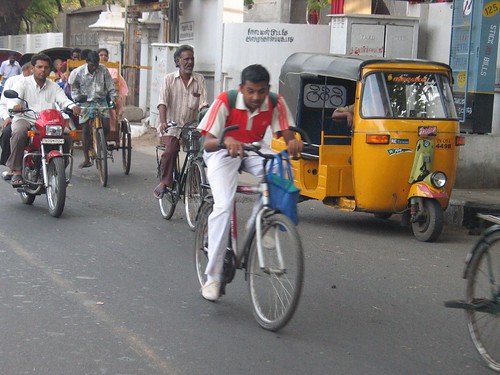Mumbai’s bicycling enthusiasts discuss ways to popularise cycling in the city to check pollution and reduce traffic congestion
(Source: Times of India)
Meeting stresses the need for dedicated infrastructure comprising separate facilities for cyclists.
MUMBAI: Why are bicycles, which don’t pollute, take up little space, are cheap and have virtually no maintenance cost, not a popular mode of travel in Mumbai? According to activists and cycling enthusiasts, the reasons are a mindset that favours motorised vehicles and a lack of infrastructure to promote cycling in the city.
 These were the two chief issues discussed during a public meeting at the Carter Road amphitheatre, Bandra (W), to popularise cycling in the city to check pollution and reduce traffic congestion. The meeting, which generated a buzz in the vicinity, had several passersby joining in. Also among the participants were young professionals working in the IT industry and call centres.
These were the two chief issues discussed during a public meeting at the Carter Road amphitheatre, Bandra (W), to popularise cycling in the city to check pollution and reduce traffic congestion. The meeting, which generated a buzz in the vicinity, had several passersby joining in. Also among the participants were young professionals working in the IT industry and call centres.
Biking enthusiasts and activists discussed the need for dedicated infrastructure comprising separate facilities for cyclists. This includes segregated lanes, bicycle parking stands at railway stations, shopping malls and public places, special signage and traffic signals for bicycles.
Activists said dedicated infrastructure for bicycle riders would allow faster short-distance journeys (between one and six km), which might even be more effective than going by car. Added to this are the health benefits of cycling, they added.
Activists Fawzan Javed and Colin Christopher, who initiated the move for the meeting, felt that starting a bicycle movement in Bandra would set a precedent for other suburbs to follow.
Javed is an architect from Mumbai, while Christopher, a student at Columbia University, New York, is currently doing a stint with Pukar, an NGO. “Once the initiative takes off, it will grow and we will have less congestion and pollution on the roads,” said Javed.
Javed, who has undertaken a project on the bicycle movement across the globe, said it was becoming popular in Asian cities and was already an established mode of transport in European cities. His idea is to have a bicycle lane network in Bandra to enable citizens to ride along freely.
Click here to read the entire article.









 The
The